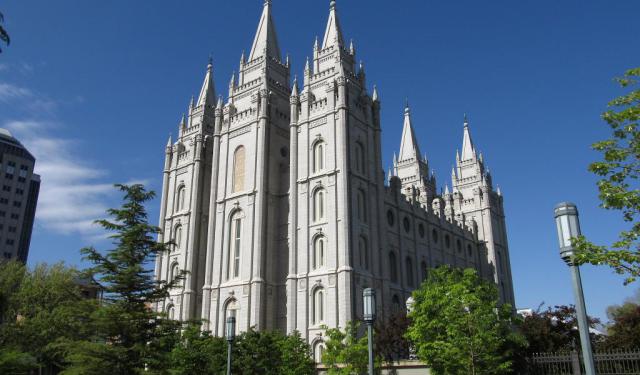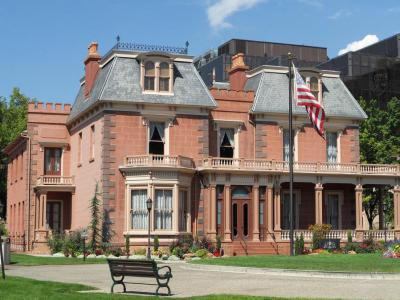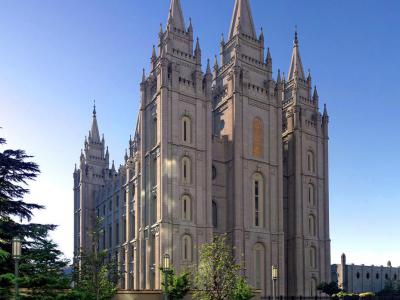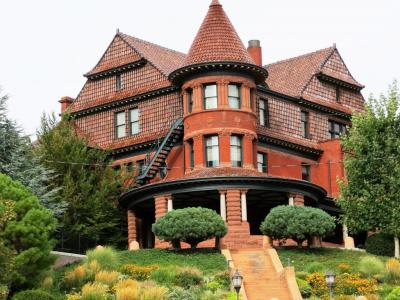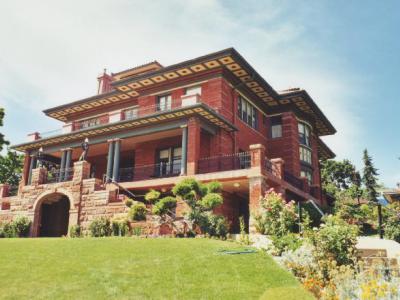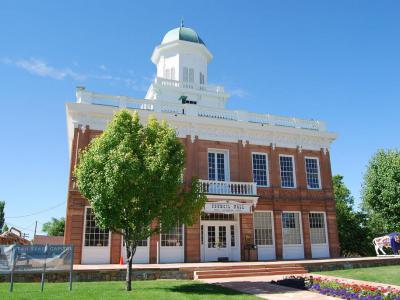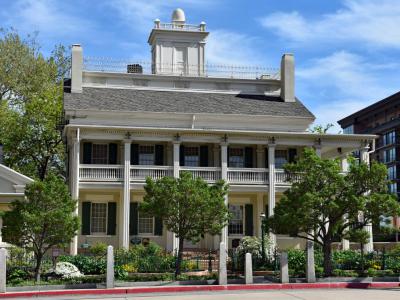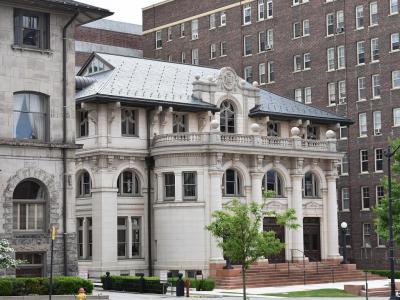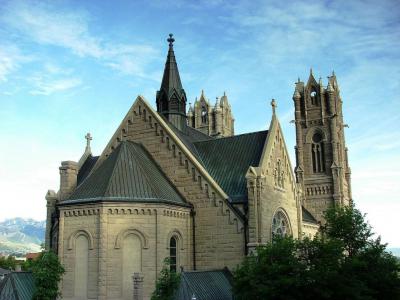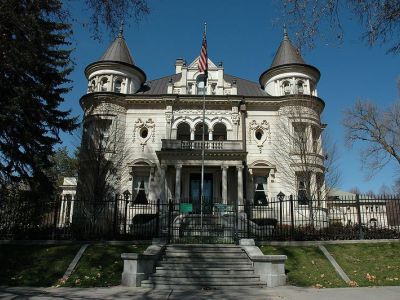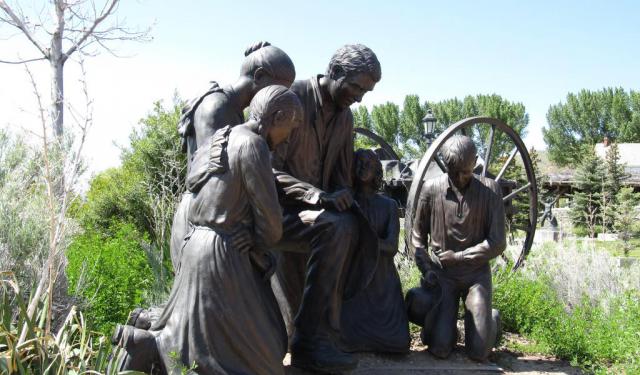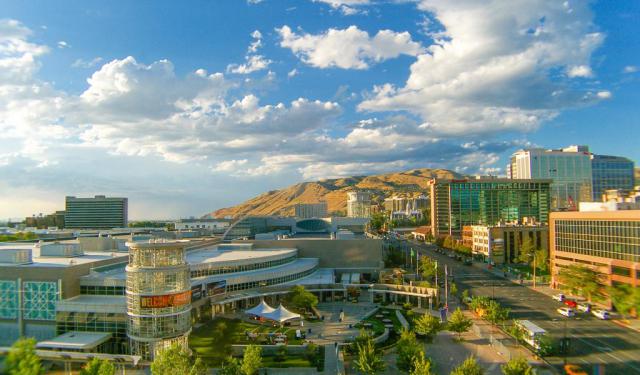Historical Buildings Tour (Self Guided), Salt Lake City
Salt Lake City’s downtown is a good place to view historical buildings and sites, each with its unique story and significance, that reflect the city’s Mormon heritage and more.
One such edifice is the Devereaux Mansion, a stunning example of Second Empire architecture that stands as a testament to the city's prosperous past. The Salt Lake Temple, an iconic symbol of the city and a masterpiece of craftsmanship showcases the dedication and skill of its builders.
The McCune Mansion exudes elegance and grandeur, reflecting the opulence of its original owner, while the Woodruff-Riter Mansion offers a glimpse into the lavish lifestyles of early Utah entrepreneurs. Council Hall, with its blend of neoclassical and Victorian design, served as the seat of government for decades and continues to stand as a symbol of civic pride.
The Beehive House, once home to Brigham Young, provides insight into the life of a prominent figure in Utah's history, while the Old Hansen Planetarium sparks curiosity and wonder with its exploration of the cosmos.
Further along the way, you may get to see the influences of other cultures, so consider a stop at the Cathedral of the Madeleine, a beacon of faith and architectural splendor, in conjunction with a visit to the Utah Governor's Mansion that offers a glimpse into the lives of the state's leaders.
These historical buildings are windows into a bygone era, allowing us to connect with the people and events that shaped Salt Lake City into the vibrant community it is today. By simply visiting them, you play a part in ensuring that Salt Lake City's historical architecture continues to enrich and inspire the local community.
One such edifice is the Devereaux Mansion, a stunning example of Second Empire architecture that stands as a testament to the city's prosperous past. The Salt Lake Temple, an iconic symbol of the city and a masterpiece of craftsmanship showcases the dedication and skill of its builders.
The McCune Mansion exudes elegance and grandeur, reflecting the opulence of its original owner, while the Woodruff-Riter Mansion offers a glimpse into the lavish lifestyles of early Utah entrepreneurs. Council Hall, with its blend of neoclassical and Victorian design, served as the seat of government for decades and continues to stand as a symbol of civic pride.
The Beehive House, once home to Brigham Young, provides insight into the life of a prominent figure in Utah's history, while the Old Hansen Planetarium sparks curiosity and wonder with its exploration of the cosmos.
Further along the way, you may get to see the influences of other cultures, so consider a stop at the Cathedral of the Madeleine, a beacon of faith and architectural splendor, in conjunction with a visit to the Utah Governor's Mansion that offers a glimpse into the lives of the state's leaders.
These historical buildings are windows into a bygone era, allowing us to connect with the people and events that shaped Salt Lake City into the vibrant community it is today. By simply visiting them, you play a part in ensuring that Salt Lake City's historical architecture continues to enrich and inspire the local community.
How it works: Download the app "GPSmyCity: Walks in 1K+ Cities" from Apple App Store or Google Play Store to your mobile phone or tablet. The app turns your mobile device into a personal tour guide and its built-in GPS navigation functions guide you from one tour stop to next. The app works offline, so no data plan is needed when traveling abroad.
Historical Buildings Tour Map
Guide Name: Historical Buildings Tour
Guide Location: USA » Salt Lake City (See other walking tours in Salt Lake City)
Guide Type: Self-guided Walking Tour (Sightseeing)
# of Attractions: 9
Tour Duration: 2 Hour(s)
Travel Distance: 4.0 Km or 2.5 Miles
Author: tamara
Sight(s) Featured in This Guide:
Guide Location: USA » Salt Lake City (See other walking tours in Salt Lake City)
Guide Type: Self-guided Walking Tour (Sightseeing)
# of Attractions: 9
Tour Duration: 2 Hour(s)
Travel Distance: 4.0 Km or 2.5 Miles
Author: tamara
Sight(s) Featured in This Guide:
- Devereaux Mansion
- Salt Lake Temple
- McCune Mansion
- Woodruff-Riter Mansion
- Council Hall
- Beehive House
- Old Hansen Planetarium
- Cathedral of the Madeleine
- Utah Governor's Mansion
1) Devereaux Mansion
The first house to be built on a scale that could be described as a "mansion" in the Salt Lake Valley, Devereaux House is also among the best-known local examples of the Second Empire style, which was widely used for public architecture in France during the reign of Napoleon III. Most prominent in this respect is the mansard roof that forms the 3rd floor – an 1860s addition to the original Gothic cottage. Owned by William Jennings, the city's first millionaire, the mansion soon became a social center for the area, hosting the territory's most prestigious visitors, including presidents and generals, foreign dignitaries and celebrities of the time.
The Church of Jesus Christ of Latter-day Saints acquired the building in 2005 and maintains it as a historic site with occasional use for receptions and other events. Noted for the high quality of its woodwork and appointments, it has been preserved in the middle of the city without a perimeter fence, so the yard has the appearance of a park. It is surrounded by larger and newer structures including Vivint Smart Home Arena, the Triad Center, the Salt Lake City Union Pacific Depot and the surrounding The Gateway development.
The Church of Jesus Christ of Latter-day Saints acquired the building in 2005 and maintains it as a historic site with occasional use for receptions and other events. Noted for the high quality of its woodwork and appointments, it has been preserved in the middle of the city without a perimeter fence, so the yard has the appearance of a park. It is surrounded by larger and newer structures including Vivint Smart Home Arena, the Triad Center, the Salt Lake City Union Pacific Depot and the surrounding The Gateway development.
2) Salt Lake Temple (must see)
The centerpiece of Temple Square, this beautiful neo-gothic edifice took 40 years to build at the direction of then Church President, Brigham Young, and has withstood the test of time since being dedicated in 1893. The granite-like quartz monzonite was quarried in Little Cottonwood Canyon, 22 miles south of the site, and was then laboriously hauled by oxen, stone by stone, until the railroad became operational in 1869. Oriented towards Jerusalem and incorporating a host of symbolic designs and decorations, many of which are visible on the exterior, it remains the largest LDS temple by floor area (253,015 square feet / 23,505.9 square meters). Its massive presence is a marvel, considering there was no electricity, no computers, nor any other artificial means used during construction. The stone masonry is so precise, there is not even mortar between the stones! And then to think the pioneers built this huge edifice in the middle of a desert guided by faith is just awesome.
As with all LDS temples, only qualifying members of the LDS faith can enter the building (used primarily for marriages, baptisms for the dead, religious ritual instruction, and meetings of the First Presidency and of the Quorum of the Twelve Apostles), but visitors can walk around the exterior and enter other historic structures nearby. During the winter months the beauties of the world-famous flower beds are replaced by nativity displays and millions of Christmas lights strung through all the trees on Temple Square, making it a hugely popular destination for visitors and locals alike.
***PIONEERS TRAIL***
As noted by the scholars, "Brigham Young was almost sole author of one of the most important chapters in the history of the American West." When the first group of pioneers, led by Young, entered Immigration Canyon overlooking the Salt Lake Valley on July 24, 1847, Young (who had been ill and was bedded in a covered wagon) rose long enough to gaze out over the valley and famously declared "This is the right place. Drive on." Those with him clearly understood that he was talking about his vision of where the Latter-Day Saints were to settle. It should be noted that Church leaders and members alike felt that settling in Utah (near the Rockies) would fulfill Isaiah 2:2 - "And it shall come to pass in the last days, that the mountain of the LORD'S house [temple] shall be established in the top of the mountains, and shall be exalted above the hills; and all nations shall flow unto it."
Perhaps among Young's greatest visible accomplishments was his initiation of the construction of the world famous Salt Lake Temple and Tabernacle on Temple Square, and the incredible construction of a system of miles and miles of irrigation canals that fulfilled the prophecy in Isaiah 35:1 "The wilderness and the solitary place shall be glad for them; and the desert shall rejoice, and blossom as the rose."
Tip:
One of the best (and free!) views of the edifice (and of Temple Square) is from the atrium and inside of The Roof restaurant, located on the top floor of the Joseph Smith Memorial Building, a short walk and elevator ride directly to the east.
As with all LDS temples, only qualifying members of the LDS faith can enter the building (used primarily for marriages, baptisms for the dead, religious ritual instruction, and meetings of the First Presidency and of the Quorum of the Twelve Apostles), but visitors can walk around the exterior and enter other historic structures nearby. During the winter months the beauties of the world-famous flower beds are replaced by nativity displays and millions of Christmas lights strung through all the trees on Temple Square, making it a hugely popular destination for visitors and locals alike.
***PIONEERS TRAIL***
As noted by the scholars, "Brigham Young was almost sole author of one of the most important chapters in the history of the American West." When the first group of pioneers, led by Young, entered Immigration Canyon overlooking the Salt Lake Valley on July 24, 1847, Young (who had been ill and was bedded in a covered wagon) rose long enough to gaze out over the valley and famously declared "This is the right place. Drive on." Those with him clearly understood that he was talking about his vision of where the Latter-Day Saints were to settle. It should be noted that Church leaders and members alike felt that settling in Utah (near the Rockies) would fulfill Isaiah 2:2 - "And it shall come to pass in the last days, that the mountain of the LORD'S house [temple] shall be established in the top of the mountains, and shall be exalted above the hills; and all nations shall flow unto it."
Perhaps among Young's greatest visible accomplishments was his initiation of the construction of the world famous Salt Lake Temple and Tabernacle on Temple Square, and the incredible construction of a system of miles and miles of irrigation canals that fulfilled the prophecy in Isaiah 35:1 "The wilderness and the solitary place shall be glad for them; and the desert shall rejoice, and blossom as the rose."
Tip:
One of the best (and free!) views of the edifice (and of Temple Square) is from the atrium and inside of The Roof restaurant, located on the top floor of the Joseph Smith Memorial Building, a short walk and elevator ride directly to the east.
3) McCune Mansion
Situated on a prominent corner location on Capitol Hill, the McCune Mansion majestically overlooks Temple Square and downtown Salt Lake City. According to the sign on site, it was built in 1901 by railroad and mining tycoon Alfred McCune, who spared little expense on design and decoration, having even financed a two-year tour of America and Europe for architect S.C. Dallas to study different designs and techniques. The chosen design was a Gothic revival plan with East Asian influence, replicating a house that the McCunes saw while driving in New York City.
Now listed on the National Register of Historic Places, the extravagant mansion features imported materials from many parts of the world. McCune had mahogany shipped from San Domingo, oak from England, and a rare white-grained mahogany from South Africa. The red roof tiles came from the Netherlands, and an enormous broad mirror wall was transported from Germany in a specially-made railroad car. The walls were adorned with moiré silks, tapestries, and Russian leather, and only the exterior was built of locally-sourced red sandstone – though some details like the lavish fireplaces used more exotic stone like Nubian marble. At its completion, the mansion had cost McCune one million dollars.
Lovingly restored to its original grandeur, the privately-owned building is open to private tours, business events, weddings and other special occasions. Historical tours are provided by Preservation Utah – call ahead to schedule your tour time.
Now listed on the National Register of Historic Places, the extravagant mansion features imported materials from many parts of the world. McCune had mahogany shipped from San Domingo, oak from England, and a rare white-grained mahogany from South Africa. The red roof tiles came from the Netherlands, and an enormous broad mirror wall was transported from Germany in a specially-made railroad car. The walls were adorned with moiré silks, tapestries, and Russian leather, and only the exterior was built of locally-sourced red sandstone – though some details like the lavish fireplaces used more exotic stone like Nubian marble. At its completion, the mansion had cost McCune one million dollars.
Lovingly restored to its original grandeur, the privately-owned building is open to private tours, business events, weddings and other special occasions. Historical tours are provided by Preservation Utah – call ahead to schedule your tour time.
4) Woodruff-Riter Mansion
Sitting up on the hillside above the corner of 200 North and State Street, this large two-and-a-half story mansion shows influence of the Second Renaissance Revival, a style popular at the turn of the century for public buildings and homes of the wealthy. The delightful bed and breakfast on site, Inn on the Hill, is open daily, allowing fantastic views of Salt Lake City.
Original owner, Edward D. Woodruff, was a Union Pacific medical doctor who, on moving to SLC, entered into commerce, having immediately become successful in a number of speculative enterprises. In 1906, at the height of his fortunes, he built this mansion and as befitted an entrepreneur of his eminence, he chose the city's prestigious firm of Headlund and Wood to execute the design in a befittingly baronial style. Made to resemble traditional English manor houses, the interior was handsomely decorated with stained glass, mahogany paneling, generous leather coverings, and mural-adorned walls.
The house eventually passed into the hands of Woodruff's daughter and her husband Franklin Riter, a lawyer who was called into active service during WWII. In his role as Head of the European Branch Office of the Judge Advocate General Army and as chief of the Army Board of Review in Europe, Riter was deeply involved in the Private Slovik case when tens of thousands of U.S. soldiers were deserting in Europe and Eisenhower approved Slovik's firing squad to set an example.
Original owner, Edward D. Woodruff, was a Union Pacific medical doctor who, on moving to SLC, entered into commerce, having immediately become successful in a number of speculative enterprises. In 1906, at the height of his fortunes, he built this mansion and as befitted an entrepreneur of his eminence, he chose the city's prestigious firm of Headlund and Wood to execute the design in a befittingly baronial style. Made to resemble traditional English manor houses, the interior was handsomely decorated with stained glass, mahogany paneling, generous leather coverings, and mural-adorned walls.
The house eventually passed into the hands of Woodruff's daughter and her husband Franklin Riter, a lawyer who was called into active service during WWII. In his role as Head of the European Branch Office of the Judge Advocate General Army and as chief of the Army Board of Review in Europe, Riter was deeply involved in the Private Slovik case when tens of thousands of U.S. soldiers were deserting in Europe and Eisenhower approved Slovik's firing squad to set an example.
5) Council Hall
The Salt Lake City Council Hall, perched on Capitol Hill in Salt Lake City, is a remarkable historical site that now houses the offices of the Utah Office of Tourism and the Utah Film Commission. Originally known as the Old Salt Lake City Hall, this structure served as the city hall from 1866 to 1894, a period marked by intense political and social shifts as the Utah Territory clashed with federal authorities. In 1975, it was designated a National Historic Landmark due to its historical significance.
Built between 1864 and 1866 under the architectural guidance of William H. Folsom, a key figure in the design work for the LDS Church, the hall was constructed of sandstone sourced from Red Butte Canyon. This Greek Revival building was meant to replace a smaller city hall that quickly became insufficient for Salt Lake City's growing population after the Utah War.
Council Hall, dedicated in January 1866 with leaders like Brigham Young present, became the city’s government center for nearly 30 years. It housed the mayor's office and departments on the first floor, while the second-floor Rose Room served as a courtroom and legislative space. In August 1874, Mayor Daniel H. Wells declared martial law from the balcony amid tensions with federal marshals at a congressional election.
After the city government relocated in 1894, the building functioned as the police headquarters until 1915 and later took on minor civic roles. In a dramatic turn, to avoid demolition for a federal office project, the hall was dismantled into 325 sandstone slabs in 1961 and reassembled on Capitol Hill. Funded largely by the LDS Church and under architect Edward O. Anderson’s direction, the restoration completed in 1962 breathed new life into this historic building. Today, renamed Council Hall, it stands as a preserved piece of Utah’s storied past.
Built between 1864 and 1866 under the architectural guidance of William H. Folsom, a key figure in the design work for the LDS Church, the hall was constructed of sandstone sourced from Red Butte Canyon. This Greek Revival building was meant to replace a smaller city hall that quickly became insufficient for Salt Lake City's growing population after the Utah War.
Council Hall, dedicated in January 1866 with leaders like Brigham Young present, became the city’s government center for nearly 30 years. It housed the mayor's office and departments on the first floor, while the second-floor Rose Room served as a courtroom and legislative space. In August 1874, Mayor Daniel H. Wells declared martial law from the balcony amid tensions with federal marshals at a congressional election.
After the city government relocated in 1894, the building functioned as the police headquarters until 1915 and later took on minor civic roles. In a dramatic turn, to avoid demolition for a federal office project, the hall was dismantled into 325 sandstone slabs in 1961 and reassembled on Capitol Hill. Funded largely by the LDS Church and under architect Edward O. Anderson’s direction, the restoration completed in 1962 breathed new life into this historic building. Today, renamed Council Hall, it stands as a preserved piece of Utah’s storied past.
6) Beehive House
Getting its name from the clearly visible beehive sculpture on top, this was one of two official residences of Brigham Young, who led the famous Mormon migration from Nauvoo, IL, to the Salt Lake Valley in 1847 and became the 2nd president (after founder Joseph Smith) of The Church of Jesus Christ of Latter-Day Saints. Like most buildings on Temple Square, the house is meticulously maintained and can be visited on a free 30-minute tour that takes you around the lower and 2nd floor. Featuring superb woodwork and craftsmanship throughout, the tour provides an excellent opportunity to dig into local history – so if you love old houses and learning about how people lived in times past, this is for you!
Constructed of adobe and sandstone, the home was designed by Young's brother-in-law and architect of the Salt Lake Temple, Truman O. Angell, who also designed the neighboring Lion House – once a home many of his wives and children. Although perhaps an over-achiever in "raising up seed", Young was nonetheless devoted to his first wife above all, as anyone who visits both the Beehive House and the Lion House can attest.
Constructed of adobe and sandstone, the home was designed by Young's brother-in-law and architect of the Salt Lake Temple, Truman O. Angell, who also designed the neighboring Lion House – once a home many of his wives and children. Although perhaps an over-achiever in "raising up seed", Young was nonetheless devoted to his first wife above all, as anyone who visits both the Beehive House and the Lion House can attest.
7) Old Hansen Planetarium
Originally built in 1904 as the Salt Lake City Public Library, this landmark was renovated in the 1960s to become the Hansen Planetarium – the go-to place for all things space. During its operation, it attracted 20% of the city's population and had the highest per capita attendance of any planetarium in the nation. The operation continued until April 2003, when it outgrew the building and was replaced by the Clark Planetarium in The Gateway. Since that time, it was remodeled into the O.C. Tanner Company Flagship jewelry store, which opened in 2009.
While still in the construction stage, the building was described as a "combination of the Doric and Ionian styles of architecture", and would later be classified in the Beaux Arts style. Only three of the four walls-the sides and front-were preserved in the 21st-century restoration, and you may notice that the rear wall now consists of glass and stone, both etched with images of the building's history. It's the largest laser stone-carving project in the world with 18 panels covering 900 square feet (84 square meters) and weighing 44,000 pounds (20,000 kilograms) in all. While the bottom of the rear wall contains repeated images from the library in 1905, the top contains images of a galaxy (signifying the Hansen Planetarium), and the middle contains an image of the founder of the company, O.C. Tanner.
Inside, a new limestone spiral staircase was built with a Flora Cascade chandelier hanging in the center of the spiral. The chandelier includes about 4,000 strands of fiber optics, more than 14,000 interwoven shapes made of white polymer and steel, and about 3,000 golden and amber glass leaves. Weighing 243 pounds (110 kilograms) and extending 26.4 feet (8.0 meters) from the ceiling, the chandelier stretches nearly the entire height of the building.
While still in the construction stage, the building was described as a "combination of the Doric and Ionian styles of architecture", and would later be classified in the Beaux Arts style. Only three of the four walls-the sides and front-were preserved in the 21st-century restoration, and you may notice that the rear wall now consists of glass and stone, both etched with images of the building's history. It's the largest laser stone-carving project in the world with 18 panels covering 900 square feet (84 square meters) and weighing 44,000 pounds (20,000 kilograms) in all. While the bottom of the rear wall contains repeated images from the library in 1905, the top contains images of a galaxy (signifying the Hansen Planetarium), and the middle contains an image of the founder of the company, O.C. Tanner.
Inside, a new limestone spiral staircase was built with a Flora Cascade chandelier hanging in the center of the spiral. The chandelier includes about 4,000 strands of fiber optics, more than 14,000 interwoven shapes made of white polymer and steel, and about 3,000 golden and amber glass leaves. Weighing 243 pounds (110 kilograms) and extending 26.4 feet (8.0 meters) from the ceiling, the chandelier stretches nearly the entire height of the building.
8) Cathedral of the Madeleine (must see)
The Cathedral of the Madeleine, located in the heart of Salt Lake City, is a testament to Catholic presence in a city known as the headquarters of the Mormon faith. This impressive structure, completed in 1909 with land gifted by the Mormons and significant construction support from Mormon volunteers, serves as the mother church of the Diocese of Salt Lake City. The only cathedral in the United States dedicated to Saint Mary Magdalene, its Neo-Romanesque sandstone exterior and cross-shaped layout honor its historical roots, while its Spanish Gothic-inspired interior, adorned with colorful ceiling murals, icons, and stained glass, adds a vibrant and sacred aesthetic.
The cathedral's contemporary Stations of the Cross include images influenced by the American Southwest alongside traditional iconography, showcasing a blend of religious and cultural significance. Inside, visitors will find a separate Blessed Sacrament Chapel, a baptismal font, and the resting place of Bishop Lawrence Scanlan, the diocese’s founding bishop who dedicated the cathedral. A relic of Saint Mary Magdalene, once housed here, was recently stolen in July 2024, marking a rare and unfortunate event for this cathedral, which was one of only two in the world with a first-class relic of the saint.
Renowned for its musical heritage, the Cathedral of the Madeleine hosts the only co-educational Catholic Choir School in the U.S., with choristers performing regularly and embarking on tours both nationally and internationally. Established in 1996, the Madeleine Choir School has become an integral part of the cathedral’s spiritual and cultural life, drawing audiences from far and wide. Visitors can explore this remarkable place, though those wishing to walk freely through the cathedral should avoid visiting during services. With its rich history, unique architectural details, and active role in the arts, the Cathedral of the Madeleine is both a spiritual landmark and a cultural treasure in Salt Lake City.
The cathedral's contemporary Stations of the Cross include images influenced by the American Southwest alongside traditional iconography, showcasing a blend of religious and cultural significance. Inside, visitors will find a separate Blessed Sacrament Chapel, a baptismal font, and the resting place of Bishop Lawrence Scanlan, the diocese’s founding bishop who dedicated the cathedral. A relic of Saint Mary Magdalene, once housed here, was recently stolen in July 2024, marking a rare and unfortunate event for this cathedral, which was one of only two in the world with a first-class relic of the saint.
Renowned for its musical heritage, the Cathedral of the Madeleine hosts the only co-educational Catholic Choir School in the U.S., with choristers performing regularly and embarking on tours both nationally and internationally. Established in 1996, the Madeleine Choir School has become an integral part of the cathedral’s spiritual and cultural life, drawing audiences from far and wide. Visitors can explore this remarkable place, though those wishing to walk freely through the cathedral should avoid visiting during services. With its rich history, unique architectural details, and active role in the arts, the Cathedral of the Madeleine is both a spiritual landmark and a cultural treasure in Salt Lake City.
9) Utah Governor's Mansion
Completed in 1902 for U.S. Senator and mining magnate Thomas Kearns, this elegant house was designed by notable Utah architect Carl M. Neuhausen, who also designed the nearby Cathedral of the Madeleine. For its construction were used the finest materials by the finest craftsmen available, resulting in a quality and style similar to that of Eastern mansions like those of the Vanderbilts and Carnegies. The mansion also served not only as a home and a place for the Senator to conduct official business, but also as a venue for entertainment where guests would dance and enjoy the music of live orchestras. During this period many political and religious dignitaries were guests in the Kearns mansion, including President Theodore Roosevelt, who was a personal friend of Senator Kearns.
With the Senator passing away in 1918, his wife donated the mansion to the State of Utah, with the condition that it serve as the Governor's Residence. In December 1993, a fire, caused by faulty wiring on the Christmas tree in the main hall, destroyed much of the structure. Governor Mike Leavitt was not at home at the time, but the First Lady and her staff were quick to notify the Fire Department, and their response prevented more significant damage. A long and painstaking restoration was begun, to return the building to its original state and salvage as much of the historical interior as possible.
The $7.8 million restoration brought the home back to its original 1902 style, while providing many current safety standards, such as a fire sprinkler system, new wiring and plumbing, new heating and cooling, a security system, and seismic upgrades.
With the Senator passing away in 1918, his wife donated the mansion to the State of Utah, with the condition that it serve as the Governor's Residence. In December 1993, a fire, caused by faulty wiring on the Christmas tree in the main hall, destroyed much of the structure. Governor Mike Leavitt was not at home at the time, but the First Lady and her staff were quick to notify the Fire Department, and their response prevented more significant damage. A long and painstaking restoration was begun, to return the building to its original state and salvage as much of the historical interior as possible.
The $7.8 million restoration brought the home back to its original 1902 style, while providing many current safety standards, such as a fire sprinkler system, new wiring and plumbing, new heating and cooling, a security system, and seismic upgrades.
Walking Tours in Salt Lake City, Utah
Create Your Own Walk in Salt Lake City
Creating your own self-guided walk in Salt Lake City is easy and fun. Choose the city attractions that you want to see and a walk route map will be created just for you. You can even set your hotel as the start point of the walk.
Pioneers Trail
After extensive religious persecution in the Eastern and Midwestern United States, the Mormon Pioneers made their way westward across the plains and mountains to a spot where Brigham Young said God had designated they should stop and settle. Unlike other social groups (farmers, miners, merchants) who created other western cities, these settlers arrived in Salt Lake Valley as a centrally organized... view more
Tour Duration: 1 Hour(s)
Travel Distance: 1.9 Km or 1.2 Miles
Tour Duration: 1 Hour(s)
Travel Distance: 1.9 Km or 1.2 Miles
Salt Lake City Downtown Walk
Salt Lake City's downtown epitomizes the city's settlement and growth. Renowned for its cleanliness, visitors often praise its meticulously planned layout, reminiscent of a Cartesian graph centered around Temple Square, a sacred site for members of The Church of Jesus Christ of Latter-day Saints (LDS).
In 1847, Brigham Young, leader of Mormon pioneer settlers, designated the site for... view more
Tour Duration: 2 Hour(s)
Travel Distance: 3.1 Km or 1.9 Miles
In 1847, Brigham Young, leader of Mormon pioneer settlers, designated the site for... view more
Tour Duration: 2 Hour(s)
Travel Distance: 3.1 Km or 1.9 Miles
The Most Popular Cities
/ view all
